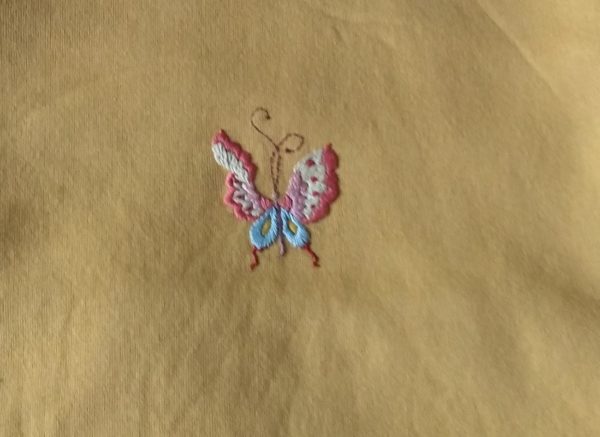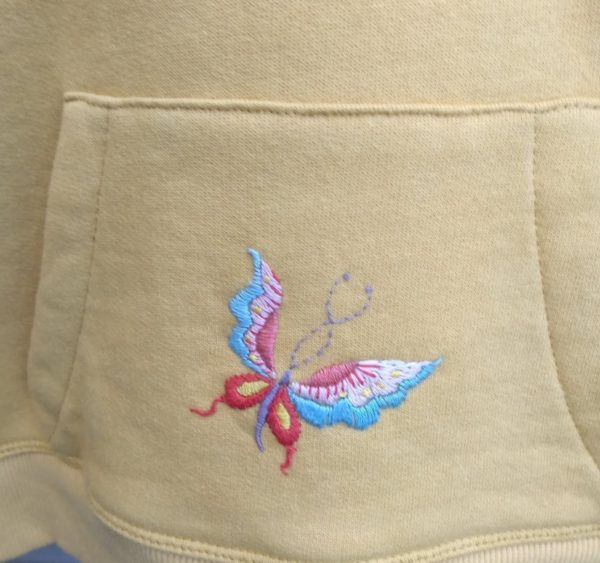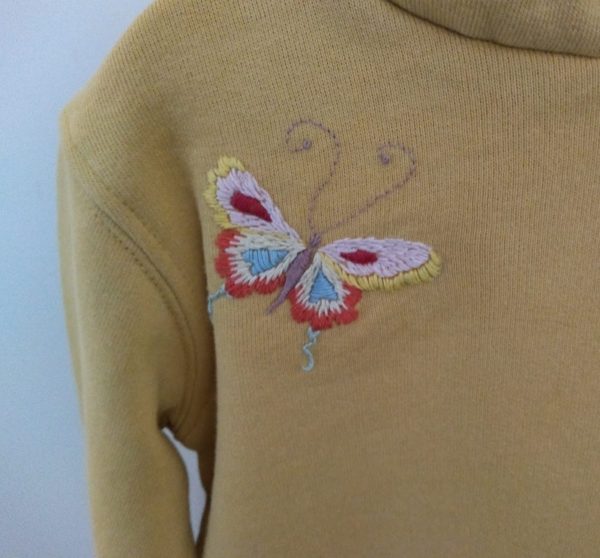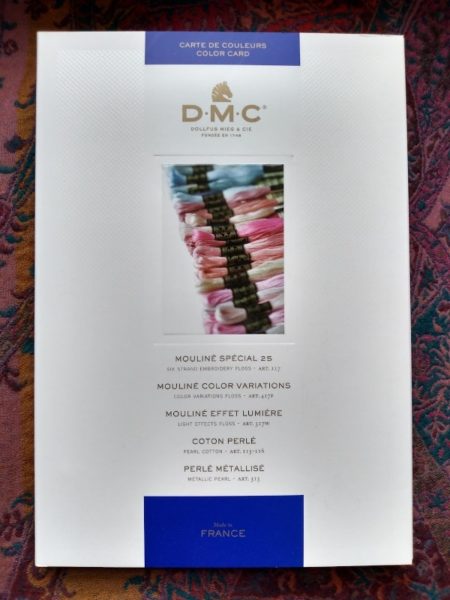
Hooded top for a 2 year old embroidered with Chinese style butterflies (hand embroidered by Mary Addison)
Very happy to record that we’ve got through January with no snow and not a lot of rain either. We’ve also felt the benefit of an increase in the hours of daylight which means I can spend about 3 minutes longer every day before giving up my position in natural light by my bedroom window – much the best place to do embroidery. No doubt we will get snow at some point. It’s only a few years ago that we had snow in the middle of March during the big Cheltenham Horse Racing Festival. Our Californian friends had come to see us by cab, straight off the plane from Heathrow. One day we were doing a sunny passegiata through Tivoli and Montpellier into town and explaining to our friends why we were surrounded by men in three piece tweed suits, women in country smart to semi wedding attire with hats everywhere Then, just a couple of days later we woke to a heavy frost, a deep white mist and, as we waved our guests goodbye in a car heading up and out of Cheltenham over the Costwolds, the snow came and kept coming.

Detail : Hooded top for a 2 year old embroidered with Chinese style butterflies (hand embroidered by Mary Addison)
Before houses had central heating winter cold was a miserable affair. As a child my bedroom window had frequently iced up by morning and although the patterns of frost on the glass were very pretty, their beauty wasn’t something you wanted to dwell too long upon. Dress quickly and hurry downstairs to the (tiny) living room where the coal fire, banked up overnight, was being nurtured into more active life by my father. At the time our telephone sat attached in the hall. In winter, only the deeply in love (my brother, 7 years my senior) found its shrill tones at all welcome.

Detail :Hooded top for a 2 year old embroidered with Chinese style butterflies (hand embroidered by Mary Addison)
But even with central heating life for those living in historic (and listed) houses is often similarly harsh when the snow comes. Being listed as historically important is not straightforwardly advantageous. It’s true there can be grants available to help restoration and repair but there are also important areas where no alteration is permissible. Perhaps the biggest problem for owners of such houses in today’s world concerns windows which must be maintained as they were when the house was built. This means no modern double glazing and often not even secondary glazing (which is anyway less effective and almost always very unattractive), and this even when cleverly designed modern solutions are available (though they are admittedly very expensive). Whether you are Hardwick Hall (“more glass than wall”), a friend’s Arts and Crafts house with Crittal (steel framed) windows, or my daughter’s 1840 Islington house (wooden sash windows) at the moment you are stuck with suffering staggering amounts of heat loss. I’m sure this will have to change as energy becomes more expensive and attention focuses on the sheer morality of using large amounts of fuel for heating when much of it literally goes straight out the window. When I first met my husband we were living in Monmouth but would often house sit for friends who had an Arts and Crafts house on the ridge to the south west of the town. Grade II* listed it faced west across the Brecon Beacons, had largish Crittal windows and was freezing in bad weather. We used to run from the kitchen with its 4 oven Aga to the other end of the house, either to spend a bit of time watching the television in front of an electric fire or cut out entertainment altogether and make a dash for bed armed with hot water bottles and additional blankets. Once, in early January, we left Monmouth after I’d finished work to make the usually comparatively short journey up the windy road out of Monmouth to our friends’ house and our dog sitting duties. Snow had been steady all day and as we headed out of town, the road looked more like a mountain pass in Switzerland with each new zig or zag of the scarcely visible route revealing abandoned cars and alarming skid marks. We turned back while we could. All night and the next day we worried about poor old Monty’s bladder (the dog we were supposed to be dog sitting). Eventually, after work the next day, we made it to the house. Monty greeted us with the joy of Persephone welcoming spring and leapt outside to do what he had to. But nowhere did we find any puddle in the kitchen. The stalwart dog had held it in for a day and a half!!

Detail : Hooded top for a 2 year old embroidered with Chinese style butterflies (hand embroidered by Mary Addison)
But I mustn’t get too optimistic, we’re only February. In the mid 1960s we even had snow in April. It was particularly memorable as a couple of classes from my secondary school had gone to Dorset on a week’s geography field trip. Athelhampton House (a Tudor mansion from 1485) and Carisbrooke Castle on the Isle of Wight (where Charles I was imprisoned in the months before his trial) were all very well in the snow but I remember the nights being a real problem. Feet cold from tramping round doing geographical type things never warmed up even when back at the hotel in the evenings. Surprisingly I’d packed a hot water bottle and I remember trying to fill it with hottish water from the basin in our bedroom. I don’t know why I never asked for my hot water bottle to be filled in the hotel’s kitchen nor why, failing that I hadn’t kept one pair of socks purely to sleep but I do remember a week of almost totally sleepless nights with feet that never defrosted. Other than that it was a fun trip!
And let’s not even think “Little House on the Prairie” when in one of the later books of the series the children wake to find snow feet deep on top of them, obliterating any sight of patchwork quilts and blankets – and almost children. Ugh. I often think of this image when I’m really cold and feel infinitely grateful for our own cosy house which has just one tiny draught of unfathomable origin.

Hooded top for a 2 year old embroidered with Chinese style butterflies (hand embroidered by Mary Addison)



